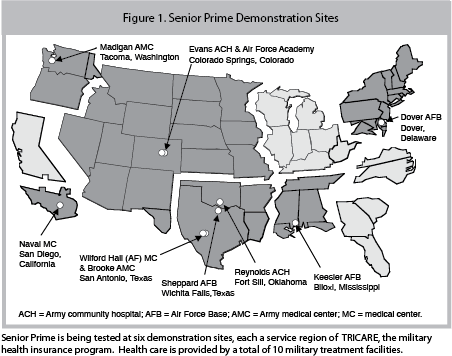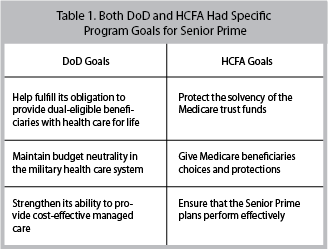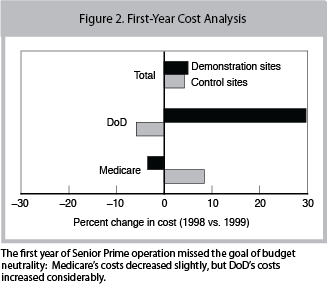Results of the first year of the TRICARE Senior Prime demonstration grant
The Department of Defense is committed to providing comprehensive health care to the men and women who serve our country. However, its health care system, one of the largest in the country, falls short of this goal for military retirees when they reach age 65 and become eligible for both military health care and Medicare.
At that point, retirees are no longer covered by the U.S. military’s health insurance program, TRICARE. Retirees with two pensions will have three options for health care coverage:
- They will continue to receive free care at military facilities, but only on a space-available basis, disrupting continuity of care and denying them health plan benefits such as prescription drug coverage. Retirees may even have difficulty accessing care. More active-duty military and family members are using military medical facilities and receiving the highest priority for care under the TRICARE Prime plan.
- You can get fee-for-service care from regular Medicare providers. However, retirees who choose this option may be required to purchase supplemental insurance to help pay for health care costs not covered by Medicare.
- Enrollment in a Medicare civilian health plan. These plans are often similar to TRICARE, but insureds can only use providers who participate in these plans.
(Congress recently authorized the extension of TRICARE eligibility to all military retirees, regardless of age.) This will give them a fourth health care option in the near future.)
The nation’s 1.4 million dual-eligible retirees have petitioned Congress and the Department of Defense to give them greater access to military health care. Congress and the Department of Defense are currently exploring options to address this group’s concerns. One experiment is Senior Prime, a Medicare program offered by TRICARE for seniors and their family members. The Department of Defense and the Health Care Financing Administration (HCFA), which administers Medicare, are piloting the program.
Senior Prime is currently being tested at six demonstration sites. The goal of the demonstration is to implement a cost-effective way to provide comprehensive health care to two eligible beneficiaries through the military health care system while maintaining budget neutrality, i.e., without increasing the total cost of government services (Medicare and DOD). RAND was asked to evaluate the extent to which Senior Prime meets this objective. Key findings after one year of Senior Prime:
- Retirees like Senior Prime. Sample centers receive positive feedback from seniors on the quality of their services. More and more people are joining Senior Prime as they turn 65 and enter Medicare.
- In its first year, Senior Prime did not meet its goal of budget neutrality. Medicare costs fell slightly, but DOL costs rose substantially.
Introduction to TRICARE Senior Prime
By law, Medicare cannot reimburse the U.S. armed forces for care provided to Medicare beneficiaries through the military health care system. However, the Balanced Budget Act of 1997 suspended this prohibition by authorizing the TRICARE Senior Prime Subsidy Demonstration. The subsidy refers to the fact that, under the demonstration program, Medicare will pay defense contractors.
Under the TRICARE program, the Department of Defense has established Senior Prime plans at six demonstration sites across the country (see Figure 1). The first site, Madigan Army Medical Center in Tacoma, Washington, became operational in September 1998, and all sites were operational by January 1999. The demonstration program was originally scheduled to continue through 2000, but the federal government extended it through 2001.
In developing Senior Prime, DoD and HCFA shared a common goal of serving beneficiaries, but had to balance their competing financial goals in payment negotiations (Table 1).
How does TRICARE Senior Prime work?
TRICARE Senior Prime is a health program designed as a Medicare+Choice plan. Medicare+Choice is the name of the new Medicare program. Under these plans, the Department of Defense assumes the financial risk of care for Medicare-eligible seniors. In return, Medicare will reimburse the Defense Forces a fixed amount per person, called a capitation payment.
However, Medicare will not make these payments unless the demonstration centers have spent at least as much money on the health care of all dual-eligible beneficiaries – both Senior Prime participants and non-participating beneficiaries – as they previously spent on dual-eligible beneficiaries. This amount is consistent with the institutions’ previous contribution level.
Senior Prime is a voluntary program with an expected total enrollment of approximately 28,000 individuals. To participate in the program, retirees agree to receive all services provided by Senior Prime at their military medical facility of residence. Other requirements, such as enrollment in Medicare Part B, also apply.
Retirees who have enrolled in TRICARE Senior Prime receive the same priority care under TRICARE Prime as active duty and non-active duty members. If necessary, they can turn to civilian providers in the Senior Prime network. Retirees also receive benefits, such as prescription drug coverage, that TRICARE typically provides but Medicare does not.
First-year results
Senior Prime’s first-year results have been mixed. “Senior Prime has been a success operationally, but not financially,” said Donna Farley, a RAND health policy analyst who led the evaluation team.
Retirees love Senior Prime
The program is so popular that more military retirees than expected are participating in the demonstration after turning 65. Consumer Reports (June 2000) called TRICARE Senior Prime the “best value” in two of the six areas sampled.
Budget neutrality remains elusive
This goal was not achieved in the first year of TRICARE Senior Prime. Figure 2 shows how Medicare costs were shifted to the Department of Defense.
- The savings to Medicare were modest. Medicare spent 3 percent less on payments to demonstration centers under Senior Prime than it did before the SIP. Most of the cost savings are due to retirees who switched from Medicare+Choice civilian plans to Senior Prime: Medicare pays a lower deductible for Senior Prime insurance than for civilian insurance. However, in the control centers selected for the RAND evaluation, Medicare paid nearly 6 percent more than last year due to price increases and increased use of Medicare services among dual-eligible beneficiaries.
- DOD costs at the demonstration centers increased by nearly 30 percent compared to what the Army spent on retirees over age 65 before Senior Prime began. Center costs increased because Senior Prime participants used the health centers much more often and received more services. In addition, DOD paid civilian providers when Senior Prime clients needed to use them, such as when military health care providers were deployed or on rotation to perform military readiness missions. Payments to civilian network providers accounted for about 10 percent of total defense spending in the first year of Senior Prime. In contrast, DOD spent 6 percent less on retirees over age 65 in the control centers than it did before Senior Prime, likely because the continued increase in active duty enrollment in TRICARE Prime reduced retirees’ access to two pensions.
Medicare compliance is demanding
DOL must comply with Medicare compliance rules to administer TRICARE Senior Prime as a Medicare+Choice plan. This has had both a positive and negative impact on the demonstration centers.
- The centers reported that HCFA’s oversight of their operations increased their accountability, improved the quality of care provided, and strengthened beneficiary protections. The centers also benefited from the transfer of skills learned in administering the TRICARE Senior Prime program, such as proactive case management, to the administration of the TRICARE Prime program by active duty staff.
- However, the centers also reported that meeting Medicare requirements places a heavy administrative burden on staff and that some requirements are unreasonable or unrelated to military health care.
Extension is interested in demonstration centers
If Senior Prime becomes a permanent program, participation will likely increase as older adults who initially chose not to participate join the trial. Demonstration centers are concerned that they will not be able to serve many more enrollees. They say that primary clinics have limited capacity and administrative staff are already overburdened. To address this, the centers have proposed that the Department of Defense allow civilian providers to serve as primary care providers for patients enrolled in the Senior Prime program. This is not allowed under current DOD regulations.
Key issues to consider if Senior Prime becomes a permanent program
“The demonstration sites have done a commendable job of making a very complex program work,” Farley said. If Senior Prime becomes a permanent program, however, DOD will need to address a number of issues.
- Management of care: Enrollees in the Senior Prime program have used military treatment centers extensively. After one year, DOD is considered to have improved its care management, but it must do more if it hopes to recover per capita costs. For example, DOD can improve care management for Senior Prime enrollees by using more efficient methods to budget funds and track staff time. However, military health care costs are also driven by the unique health care readiness and support requirements of military operations, which cannot be controlled by individual agencies.
- Capitation and Reimbursement Rules: Medicare capitation payment to the Department of Defense for the provision of demonstration care is based on a complex formula. As a result, Senior Prime payments per insured are 7 to 12 percent lower than Medicare payments to civilian health plans in the same market. The formula should be adjusted to make the payments more comparable. In addition, the historical caseload calculation that determines when Medicare makes per capita payments to the defense needs to be clarified and updated.
- Capacity Issues: Resolving this issue may require reinterpreting some of the Senior Premium rules. For example, DOD could allow TRICARE Senior Prime enrollees to use civilian caregivers rather than military personnel, as under TRICARE Prime. This would give DOD more flexibility to ensure access to care, but could weaken its ability to manage operating costs.
- Is Medicare really worth it? The DOD’s biggest problem is the administrative costs it faces in running Senior Prime programs as Medicare-like health plans. Some case studies have suggested that DOD consider simpler, non-Medicare alternatives.
Read our general and most popular articles
- Diaetoxil
- Nuubu
- Regener 8
- CBD Vital
- Nordic Oil
- Potencialex
- Diaetostat
- Figur Kapseln
- Viscerex
- Prostaphytol
- Nutra Prosta
- Nutra Flex
- Diaetolin
- Matcha Slim
- Hepafar Forte
- Derila Kissen
- Exodermin
- HHC
- HHC Vape
- KU2 Cosmetics Hyaluronsäure Serum
- Liba Capsules
- KetoXplode
- Green Gummies
- Liver Ignite
- Ketoxboom Fruchtgummis
- Viagra Alternative
- Gundry MD Energy Renew
- ProDentim
- Phentermine Over The Counter
David W. Newton is a board certified pharmacist and also has been a board member for boards of examiners for the National Association of Boards of Pharmacy since 1983. His areas of expertise are primarily pharmaceuticals as well as cannabinoids. You can read an article about his expertise in CBD on the National Library of Medicine.
Reviewed by: Kim Chin and Marian Newton



